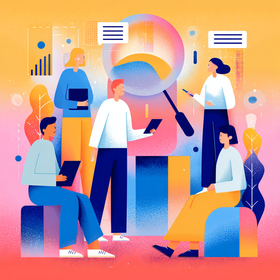D UX and Neuroscience
Por Redacción Aguayo
Understanding how our minds react to screens, buttons, and animations can be the key difference between a product that feels natural and one that feels frustrating, even if it functions well. Neuroscience gives us clues into how we perceive, feel, and make decisions in digital environments, opening a world of possibilities for designing more human, intuitive, and effective experiences. 🧠

How Our Brain Shapes Digital Interaction
Designing with the human mind in mind is not just a poetic metaphor—it's a practical necessity. Every digital interaction involves fast, limited, and deeply emotional brain processes. By understanding how our cognitive system works, UX design can move beyond functionality to true significance. This approach not only enhances the user experience but also boosts product effectiveness, reinforces memory, and strengthens the user relationship. From attention to memory, from biases to the senses—the brain is involved in every pixel we touch.
The Brain: The Real End User (Expanded)
Every digital interface exists to be understood and used by people—but more precisely, by their brains. Behind every interaction—every click, scroll, swipe, or hesitation—there’s a complex neurological process unfolding in milliseconds. It’s not the hand that clicks, it’s the brain deciding whether or not it’s worth it. It’s not the eyes that see a button, but the brain that interprets its purpose and emotional tone.
When we design digital products, we’re not just creating layouts—we’re shaping how the brain perceives, reacts, and remembers. Understanding this shifts our mindset: instead of designing for abstract “users,” we start designing for neural patterns, cognitive thresholds, and emotional triggers.
Here’s how the brain shapes digital interaction:
- Visual Dominance: The brain processes images 60,000 times faster than text. It looks for shapes, colors, and patterns first—because these are evolutionarily hardwired cues for safety, relevance, or novelty. Prioritizing visuals over text isn’t just aesthetic—it’s neurological.
- Emotional Filtering: Colors and shapes aren’t just seen; they’re felt. A rounded corner might feel friendlier than a sharp edge. A deep blue can evoke calm, while a red might trigger urgency. These are not design trends—they’re brain responses.
- Cognitive Load Management: The brain avoids effort when possible. If an interface is cluttered or unclear, the user won’t consciously “decide” it’s too much—they’ll just leave. Clean interfaces reduce cognitive strain and increase the likelihood of action.
- Mental Shortcuts: Heuristics are the brain’s way of moving fast. Familiar patterns, expected layouts, and standard icons help users operate on autopilot. When things “just make sense,” it’s not magic—it’s memory and pattern recognition at work.
- Limited Working Memory: The average person can hold about 4 pieces of information at once. That means multitasking is a myth and information overload is a real barrier. Interfaces need to guide the user through one clear step at a time.
Recognizing these brain behaviors doesn’t mean dumbing down design—it means designing smarter. It means working with the brain, not against it. Designing for the brain is about refining complexity into clarity, and turning interaction into intuition.
Attention, Emotion, and Memory: The Three Pillars of Brain-Centered Design (Expanded)
UX has long championed usability—and rightly so. But to go from functional to truly engaging, we need to align with the brain’s most influential processes: attention, emotion, and memory. These three pillars are not just complementary—they’re interdependent.
Attention
Attention is the gatekeeper of the mind. If a design doesn’t earn attention, nothing else matters—it won’t be seen, processed, or remembered. And in a hyper-distracted digital environment, attention is a battlefield.
Capturing attention means designing with intention:
- Use contrast and hierarchy to highlight the most important actions.
- Animate only when necessary—and make it meaningful.
- Place key content where the eyes naturally go (upper-left, central focal points).
The brain’s “spotlight” of attention moves quickly. We must ensure that what needs to be seen gets seen—within seconds.
Emotion
Emotion drives decision-making more than logic ever will. Neuroscience shows that people with damaged emotional centers struggle to make even simple choices. Emotions shape perception, guide focus, and encode memories.
Designs that evoke emotion—through warmth, delight, surprise, or even frustration—tend to stick:
- A delightful microinteraction can create a moment of joy.
- A calming color scheme can reduce anxiety in complex tasks.
- Thoughtful copywriting can shift a tone from sterile to empathetic.
Emotion is not fluff. It’s the secret engine of user experience—and the strongest path to brand loyalty.
Memory
For a user to return, they must remember how your product works—and how it felt to use it. The brain forms memories through repetition, consistency, and emotional salience.
To support memory:
- Reinforce patterns. Keep buttons, labels, and interactions consistent across the product.
- Avoid surprises unless they’re delightful. Inconsistencies break the mental model and force relearning.
- Use familiar design structures (like card layouts or tab navigation) to anchor new information in known frameworks.
Memory isn’t just about recall—it’s about recognition. Users shouldn’t have to think hard to remember how to use your product. It should feel natural, like muscle memory for the mind.
Design Elements That Directly Impact Neurological Response
Design isn’t just seen—it’s interpreted. Every element has a measurable effect on brain activity. Some of the most significant include:
Clear Visual Hierarchies
The brain follows reading patterns and looks for visual anchors. Well-defined headers, high contrast between key elements, and white space help guide the eye and thinking. This reduces mental friction and makes decision-making easier.
Immediate Feedback
A button that changes color, a vibration after a click, a subtle animation indicating progress—all confirm to the brain that it got it right, releasing dopamine. This positive reinforcement strengthens learning and generates instant satisfaction.
Visual Rhythm and Microinteractions
The human eye perceives rhythm in navigation. Smooth transitions, consistent response times, and well-crafted interactive elements create a sense of flow that calms the user and improves perceived efficiency.
Cognitive Bias: Enemy or Ally in Design?
Cognitive biases are not flaws in thinking—they’re evolutionary shortcuts. The brain prefers to save energy and uses “quick rules” to make decisions. Far from being enemies of design, these biases can be allies when used ethically and clearly.
Primacy and Recency Effect
What appears first and last is remembered best. This applies to menu structures, form layouts, or onboarding flows. Leveraging these moments improves retention.
Loss Aversion
Users react more strongly to potential loss than to an equivalent gain. Messages framed as “avoid losing your progress” are more effective than “earn more points.”
Cognitive Fluency Effect
The easier something is to process, the more trustworthy it seems. This translates to clean interfaces, clear visual hierarchy, and straightforward language. What’s quickly understood is more highly valued.
Neurodesign in Action: Informed, Not Instinctive Decisions
Applying neuroscience to UX design isn’t “brain magic”—it’s working with real information. It’s not about manipulation, but about aligning with how the human mind truly functions. To achieve this, we can ask questions like: What parts of the interface create unnecessary cognitive load? Where can an emotional cue improve memory? What stage of the flow could benefit from a mental micro-reward? Does the tone of the text convey confidence, urgency, or confusion? Are we using navigation patterns already familiar to the brain? These questions not only fine-tune the design—they humanize it, shifting from purely aesthetic or technical logic to a perceptual, emotional, and meaningful one.
Multisensory Design and Digital Synesthesia
Though screens are primarily visual, the brain is not. It’s multisensory. We interpret the world through multiple channels, and digital experiences can simulate this sensory richness. Short sounds upon task completion provide satisfaction. Vibrations in mobile interfaces act as physical confirmation. 3D icons and soft shadows simulate materiality, helping the brain “feel” the interface, not just see it. Designing multisensory experiences isn’t about overwhelming users with stimuli, but about harmonizing them. A coherent integration of sight, sound, and touch reduces mental effort and strengthens emotional connection.
Neuroethics in Design: How Far Should We Go?
Understanding how the brain works carries ethical responsibility. We can influence decisions, reinforce behaviors, and evoke emotions—but to what end? Neuroscience-driven UX design should avoid deliberately hiding options to manipulate, inducing anxiety or FOMO to boost interaction, or exploiting cognitive vulnerabilities for business gain without user benefit. Good UX respects, informs, guides, and supports—it doesn’t trick. In responsible hands, neuroscience helps create more human, not more addictive, experiences.
What’s Next for Neuroscience-Based UX Design?
What seems sophisticated today will be standard tomorrow. Neurological analysis tools like eye-tracking, EEG sensors, and emotional recognition are becoming more common in UX labs. But even without advanced tech, applying basic brain principles can revolutionize design. The future leans toward experiences personalized not just by demographics, but by emotional states; adaptive interfaces responding to user attention and fatigue; and digital environments that feel alive, connected, and attuned to real people—not industry ideals.
UX design shouldn’t just be usable or beautiful—it should be neuro-compatible. Understanding how the brain works is one of the most valuable investments we can make to build truly memorable, useful, and ethically designed products.
Conclusion:
Neuroscience reminds us that behind every “user” is a human being with a limited, emotional, and highly adaptive brain. We don’t navigate websites or use apps like rational robots—we’re guided by fleeting attention, unconscious biases, intense emotions, and selective memory. Understanding this reshapes our practice as UX designers.
Designing based on brain function isn’t a trend—it’s an essential evolution. It means reducing cognitive friction, harnessing the power of emotions, building positive memories, and using biases ethically and responsibly. It takes us beyond making interfaces that simply "work" toward creating experiences that feel natural, fluid, and unforgettable.
Neuroscience doesn’t replace creativity—it amplifies it. It doesn’t take the soul out of design—it adds depth. It helps us design not just for eyes or fingers, but for the whole mind. The true challenge of UX




























































































































































































































